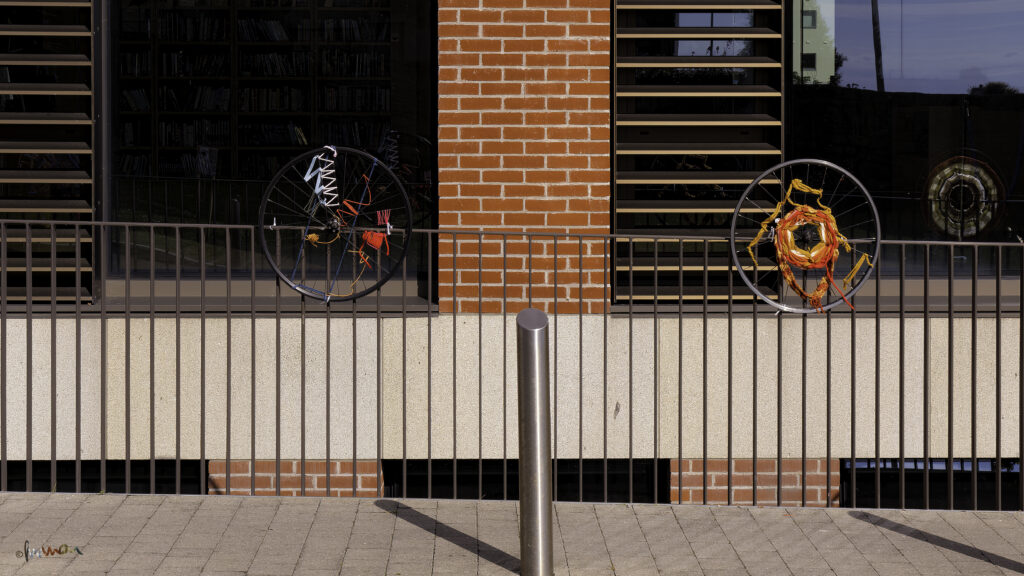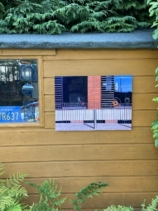
Fujifilm X-T4 | Fujifilm XF18-55 mm F2.8-4 R LM OIS | 49 mm | 1/250s | f/13 | ISO 200 | handheld
This photograph is a commentary on a pause I took while walking around Dún Laoghaire, looking for photographic scenes to illustrate one of my monthly chapbooks. That’s when I happened upon an art installation hung on the fence of the Lexicon library. Some of the pandemic restrictions were still in force on that bright, June day 2021. The library itself had been closed so there was no one to ask about the scene. I learned later that it was coordinated / curated by artist Trudy Feighery of Tru Tru in conjunction with students from Newpark School.
I tend to see ‘street furniture’ as metaphors for space and time. In this Lexicon pause, I’d also seen an expression of the tension brought about by the pandemic.
I paused to react to that tension. I thought more about it overnight and returned the next day armed with early morning sunlight and a digital camera.
The library shelves held books but from outside, only their covers were legible during that lockdown period. The external windows hosted transient reflections caused by the passing sun but what you could see depended on the time-of-day and cloud cover. The fence appeared to be adorned with prayer wheels, perhaps as requests for divine intervention to end the pandemic.
There was a permanent architectural warp and weft pattern on the building behind the enclosing fence. Maybe the repurposed bicycle wheels represented circular looms with which the children would weave a new future?
And there was the awkward fence post, perhaps unregistered in my saccadic passing view, that couldn’t be ignored by a camera. The post added tension to a scene intensified by the leaning lampposts and asymmetric, clashing patterns that constituted the rectangular fabric of a potential image.
And those red bricks, Dorchester Red Stock, what did they suggest? Were they a nod to the Victorian buildings erected when the harbour was the largest man-made harbour on a planet dominated by colonising empires?
What about the cotton threads adorning the bicycle wheels? Was this a reference to the imperial, circular scourge that enslaved ever more people in order to faster pick the cotton that drove the mills that drove the prices into the ground that grew the cotton that clothed the empires?
The school children were unseen but their work was not. What will their futures hold in a world driven by an unsustainable demand for growth that resumed after the pauses of the pandemic?
My selection of this image for public submission was inspired by the street scenes of Edward Hopper. And also by the vibrant photography of Alex Webb who opined that: ‘Everything is in a state of such acute tension that a new kind of equilibrium is possible.’
This photograph is exhibited in the group exhibition Pause. It is presented as a print on metal. It’s 50 x 69.7 cm and comes with hanging rails. It’s priced at €950 and is 1 of a limited and numbered edition of 9.


Note: the dynamic range of the camera has resolved details from the covers of those books. Printing directly on metal retains that resolution but it takes strong light to render the spines visible to our eyes. I hung this print in our garden over the last summer and we could see the image change when direct sunlight illuminated the titles on the spines of the books on the barely visible library shelves.
